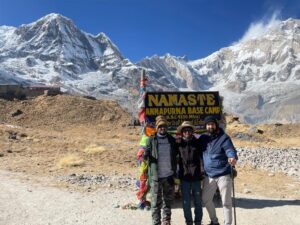In the local language, Langtang means a place where the OX was found. Long ago people of Langtang imported an Ox from Tibet to use it for religious purpose. But the Ox escaped and was missing for a long time. Looking for the Ox for few days they came to find the Ox at a place in the Himalayas and named if Langtang. This was history heard from the people, our team collect real data from different sources.
Langtang valley is a Himalayan valley in the mountains of north-central Nepal, known for its trekking routes and natural environment.
Langtang valley lies within Langtang National Park, was established in 1976 as Nepal’s first Himalayan National Park and the country’s fourth protected area. It exceeds an elevation range of 6,450 m (21,160 feet) and cover an area of 1,710 km2 (660 square meter) in the Nuwakot, Rasuwa, and Sindhupalchowk districts of the central Himalayan region. Ecology, The Park contains a wide variety of climatic zones, from subtropical to alpine.Approximately 25% of the park is forested. Trees include the deciduous oak and maple, evergreens like pine, and various types of rhododendron. Animal life includes the Himalayan black bear, Himalayan tahr, Assam macaque, snow leopard, yak, red panda and more than 250 species of birds.
Among themselves, the local inhabitants of the Langtang valley refer to each other as ‘Langtangpa’. They generally follow Tibetan Buddhism, and speak a Tibetan language that is closely related to the Tibetan spoken in Kyirong, southern Tibet. The Langtangpas regard the mountain Langtang Lirung as their ‘yu-lha’, their local country god. However, in the state census, the Langtangpas are categorized as Tamang. Langtang valley is believed to be the Beyul Dagam Namgo, one of the many hidden valleys blessed by Guru Padmasambhava.
The nearest motorable roadhead for the Langtang valley is Shyaphrubesi, which is also the base for most treks into the Langtang valley. The distance of Shyaphrubesi from Kathmandu is 80km. But due to bad road conditions, it usually takes 6-8 hours to drive from Kathmandu to Shyaphrubesi. Just as for the Langtang National Park, entering the Langtang valley requires everyone except locals to have the TIMS permit and the Langtang National Park entry permit.
The Langtang valley trek, from Shyaphrubesi to Kyanjin Gumba and back, is known to be the third most popular trek in Nepal, after the Annapurna circuit and Everest base camp treks. There are several treks that go through the Langtang valley and link it to nearby valleys. In most of these treks, one can stay at local ‘tea-houses’, which are run by locals in nearly every village in the valley, and where one gets basic lodging and food. There are several mountain-climbing options available too in the Langtang valley, ranging from relatively easy-to-climb peaks around 5,000m high, such as Kyanjin Ri and Cherko Ri, to technically challenging peaks, such as Dorje Lhakpa and Langtang Lirung

